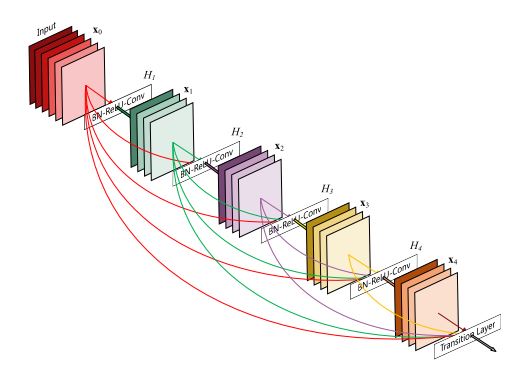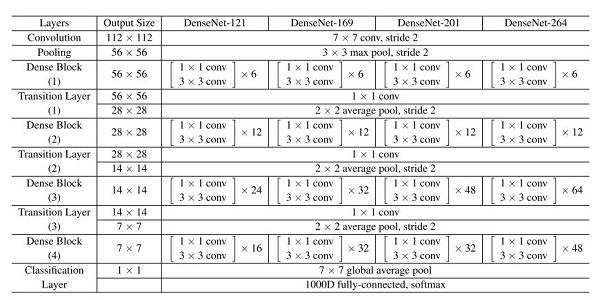概要
ディープラーニングの画像認識モデルである DenseNet を解説し、Pytorch の実装例を紹介します。
DenseNet
DenseNet について、論文 Densely Connected Convolutional Networks に基づいて解説します。
Dense Layer
Dense Layer は、複数の畳み込み層、Batch Normalization、ReLU から構成されます。DenseNet では、ReLU -> Batch Normalization -> Conv の順番で適用します。最初に 1×1 の畳み込みで次元数を削減したあと、3×3 の畳み込みを適用します。 各畳み込み層の出力数は以下のようになります。ただし、$k$ は後で紹介する growth rate を表します。
| 層 | 出力の形状 |
|---|---|
| 入力 | (N, C, H, W) |
| ReLU | (N, C, H, W) |
| Batch Normalization | (N, C, H, W) |
| 1×1 Conv | (N, k * 4, H, W) |
| ReLU | (N, k * 4, H, W) |
| Batch Normalization | (N, k * 4, H, W) |
| 3×3 Conv | (N, k, H, W) |
Dense Block
Dense Block は連続した複数の Dense Layer から構成されるブロックです。Dense Block の入力を $x_0$、$l$ 個目の Dense Layer を $H_l(x)$、$l$ 個目の Dense Layer の出力を $x_l$ としたとき、$H_l(x)$ は Dense Block の入力 $x_0$ 及びそれより前のDense Layer $H_1, H_2, \cdots, H_{l – 1}$ の出力 $x_1, x_2, \cdots, x_{l – 1}$ をチャンネル方向に結合したものが入力となります。
$$ H(\text{concat}(x_0, x_1, x_2, \cdots, x_{l -1})) = x_l $$
$l$ 個目の Dense Layer の入力のチャンネル数は、Dense Block の入力 $x_0$ のチャンネル数を $k_0$、各 Dense Layer の出力のチャンネル数を $k$ としたとき、
$$ x_l の入力チャンネル数 = k_0 + k (l – 1) $$で計算できますが、この値 $k$ を growth rate といいます。
Dense Block の出力も、Dense Block の入力及びすべての Dense Layer の出力をチャンネル方向に結合した
$$ DenseBlock ブロックの出力 = \text{concat}(x_0, x_1, \cdots, x_L) $$になります。ただし、$L$ は Dense Layer の数です。
Transition Layer
DenseNet は DenseBlock を複数重ねた構造になっています。Dense Block の間には、1×1 の畳み込みでチャンネル数を削減し、平均プーリングで大きさを削減する Transition Layer が挿入されています。
DenseNet

DenseNet の最初には kernel_size=7, stride=2, out_channels=2 * grouth_rate の畳み込みがあります。
最後の Dense Block の後には、Global Average Pooling 層及び分類用の全結合層があります。
Pytorch の実装
Pytorch では、以下の DenseNet が提供されています。以下に Pytroch の実装例を紹介します。実用上は torchvision.models の DenseNet を使用してください。
| モデル名 | 関数名 | パラメータ数 | Top-1 エラー率 | Top-5 エラー率 |
|---|---|---|---|---|
| Densenet-121 | densenet121() | 7978856 | 25.35 | 7.83 |
| Densenet-161 | densenet161() | 28681000 | 24 | 7 |
| Densenet-169 | densenet169() | 14149480 | 22.8 | 6.43 |
| Densenet-201 | densenet201() | 20013928 | 22.35 | 6.2 |
Dense Layer を作成する
Dense Layer を作成します。forward() の x には、Dense Block の入力及びそれより前の Dense Layer の出力がリストで渡されるので、torch.cat(x, 1) でチャンネル方向に結合しています。
import torch
import torch.nn as nn
import torch.nn.functional as F
class DenseLayer(nn.Module):
def __init__(
self,
in_channels,
growth_rate,
drop_rate,
):
super().__init__()
self.norm1 = nn.BatchNorm2d(in_channels)
self.relu1 = nn.ReLU(inplace=True)
self.conv1 = nn.Conv2d(in_channels, growth_rate * 4, kernel_size=1, bias=False)
self.norm2 = nn.BatchNorm2d(growth_rate * 4)
self.relu2 = nn.ReLU(inplace=True)
self.conv2 = nn.Conv2d(growth_rate * 4, growth_rate, kernel_size=3, padding=1, bias=False)
self.dropout = nn.Dropout(p=drop_rate)
def forward(self, x):
x = torch.cat(x, 1)
x = self.norm1(x)
x = self.relu1(x)
x = self.conv1(x)
x = self.norm2(x)
x = self.relu2(x)
x = self.conv2(x)
x = self.dropout(x)
return xDense Block を作成する
Dense Block を作成します。forward() 中にリストに Dense Layer の出力を追加していってます。また、Dense Block の出力は、Dense Block の入力及びすべての Dense Layer の出力をチャンネル方向に結合したものなので、torch.cat(x, 1) で結合を行っています。
class DenseBlock(nn.ModuleDict):
def __init__(
self,
num_layers,
in_channels,
growth_rate,
drop_rate,
):
super().__init__()
for i in range(num_layers):
layer = DenseLayer(
in_channels + i * growth_rate,
growth_rate=growth_rate,
drop_rate=drop_rate,
)
self.add_module(f"denselayer{i + 1}", layer)
def forward(self, x0):
x = [x0]
for name, layer in self.items():
out = layer(x)
x.append(out)
return torch.cat(x, 1)Transition Layer を作成する
Transition Layer を作成します。1×1 の畳み込みでチャンネル数を削減したあと、平均プーリングで大きさを削減します。
class TransitionLayer(nn.Sequential):
def __init__(self, in_channels, out_channels):
super().__init__()
self.add_module("norm", nn.BatchNorm2d(in_channels))
self.add_module("relu", nn.ReLU(inplace=True))
self.add_module("conv", nn.Conv2d(in_channels, out_channels, kernel_size=1, bias=False))
self.add_module("pool", nn.AvgPool2d(kernel_size=2, stride=2))DenseNet
以下のパラメータに従い、DenseNet 全体を作成します。

class DenseNet(nn.Module):
def __init__(
self,
growth_rate,
block_config,
drop_rate=0,
num_classes=1000,
):
super().__init__()
# 最初の畳み込み層を追加する。
self.features = nn.Sequential()
self.features.add_module(
"conv0", nn.Conv2d(3, 2 * growth_rate, kernel_size=7, stride=2, padding=3, bias=False)
)
self.features.add_module("norm0", nn.BatchNorm2d(2 * growth_rate))
self.features.add_module("relu0", nn.ReLU(inplace=True))
self.features.add_module("pool0", nn.MaxPool2d(kernel_size=3, stride=2, padding=1))
# Dense Block 及び Transition Layer を作成する。
in_channels = 2 * growth_rate
for i, num_layers in enumerate(block_config):
block = DenseBlock(
num_layers=num_layers,
in_channels=in_channels,
growth_rate=growth_rate,
drop_rate=drop_rate,
)
self.features.add_module(f"denseblock{i + 1}", block)
in_channels = in_channels + num_layers * growth_rate
if i != len(block_config) - 1:
# 最後の Dense Block でない場合は、Transition Layer を追加する。
trans = TransitionLayer(in_channels=in_channels, out_channels=in_channels // 2)
self.features.add_module(f"transition{i + 1}", trans)
in_channels = in_channels // 2
self.features.add_module("norm5", nn.BatchNorm2d(in_channels))
self.features.add_module("relu5", nn.ReLU(inplace=True))
self.features.add_module("pool5", nn.AdaptiveAvgPool2d((1, 1)))
self.classifier = nn.Linear(in_channels, num_classes)
# 重みを初期化する。
self._initialize_weights()
def _initialize_weights(self):
for m in self.modules():
if isinstance(m, nn.Conv2d):
nn.init.kaiming_normal_(m.weight)
elif isinstance(m, nn.Linear):
nn.init.constant_(m.bias, 0)
def forward(self, x):
x = self.features(x)
x = torch.flatten(x, 1)
x = self.classifier(x)
return x
def densenet121():
return DenseNet(growth_rate=32, block_config=(6, 12, 24, 16))
def densenet169():
return DenseNet(growth_rate=32, block_config=(6, 12, 32, 32))
def densenet201():
return DenseNet(growth_rate=32, block_config=(6, 12, 48, 32))
def densenet264():
return DenseNet(growth_rate=48, block_config=(6, 12, 64, 48))









コメント